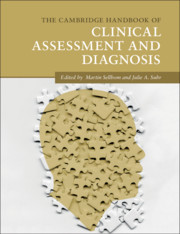Book contents
- The Cambridge Handbook of Clinical Assessment and Diagnosis
- The Cambridge Handbook of Clinical Assessment and Diagnosis
- Copyright page
- Contents
- Figures
- Tables
- Contributors
- Acknowledgments
- 1 Introduction to the Handbook of Clinical Assessment and Diagnosis
- Part I General Issues in Clinical Assessment and Diagnosis
- Part II Specific Clinical Assessment Methods
- Part III Assessment and Diagnosis of Specific Mental Disorders
- Part IV Clinical Assessment in Specific Settings
- 32 Screening and Assessment in Integrated Primary Care Settings
- 33 Psychological Assessment in Forensic Settings
- 34 Assessment Issues within Neuropsychological Settings
- 35 Assessment in Educational Settings
- Index
- References
32 - Screening and Assessment in Integrated Primary Care Settings
from Part IV - Clinical Assessment in Specific Settings
Published online by Cambridge University Press: 06 December 2019
- The Cambridge Handbook of Clinical Assessment and Diagnosis
- The Cambridge Handbook of Clinical Assessment and Diagnosis
- Copyright page
- Contents
- Figures
- Tables
- Contributors
- Acknowledgments
- 1 Introduction to the Handbook of Clinical Assessment and Diagnosis
- Part I General Issues in Clinical Assessment and Diagnosis
- Part II Specific Clinical Assessment Methods
- Part III Assessment and Diagnosis of Specific Mental Disorders
- Part IV Clinical Assessment in Specific Settings
- 32 Screening and Assessment in Integrated Primary Care Settings
- 33 Psychological Assessment in Forensic Settings
- 34 Assessment Issues within Neuropsychological Settings
- 35 Assessment in Educational Settings
- Index
- References
Summary
Most behavioral health care occurs within primary care settings. Increasingly, behavioral health providers are integrating into these settings to enhance the ability of medical providers to assess and treat behavioral health concerns. Compared to specialty care, primary care is optimized, in part through brief appointments, to provide care to a larger proportion of the population. Behavioral health integration models, such as the Primary Care Behavioral Health model, require behavioral health providers to adapt to the environmental demands of primary care and focus on providing targeted brief screenings and assessments to quickly identify presenting concerns. In this chapter, we discuss the special considerations for conducting screenings and assessments in primary care and describe brief and targeted measures appropriate for this environment.
Keywords
- Type
- Chapter
- Information
- The Cambridge Handbook of Clinical Assessment and Diagnosis , pp. 447 - 461Publisher: Cambridge University PressPrint publication year: 2019

